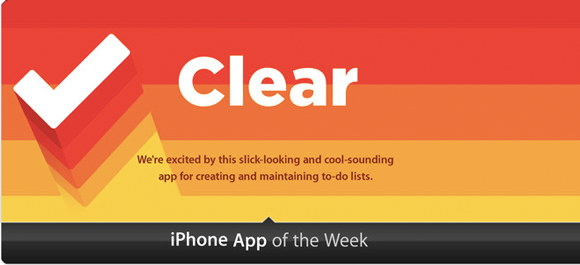Innovation and Success with Software, Part 1
The recent success of Realmac Software‘s Clear App, which is leading the iTunes paid apps top charts as of today, let me once again wonder on the secrets of successful software. What is behind this simple app to make people so fascinated and enthusiastic about it (besides that it’s “slick-looking” and “cool-sounding”)?

What is it about that Buzz?
The obvious answer is that this software is innovative, as noted rather casually in several reviews (see here and here). In Clear‘s case, the innovative element is the simplification of working with a to-do list and minimalism in which the user interface is implemented. In other words, the innovation lies in the reduction of complexity of the tasks fulfilled by the app and in the rather disruptive (or „breaking“) idea of user interface implementation.
On Innovation in Software
While the basic idea of an innovation is that it is just about the introduction of something new, one could better say that an innovation is the first implementation of a new idea, or concept (with the new idea or concept sometimes being an invention). With regard to software it may be further defined in two distinct areas:
- A software product may be innovative either with respect to the things it does, i.e. the way it helps the user to fulfil a specific task (e.g. by simplifying workflows, putting more data together in less time), or with respect to how it does so, i.e. the way it interacts with the user (e.g. by having a simpler user interface).
- A software product may contain either a sustaining (or incremental) innovation or a disruptive innovation. On this categorization, see Luke Williams on Disruptive Thinking or Clayton Christensen on disruptive innovation.
Regarding innovation in software products, methodologies of how to to create innovations have been defined (see e.g. The Art of Software Innovation), but not much is to be found about a definition of what makes software innovative. I believe that innovation in software products is very often not about adding new features and not about making a product more powerful, but about making it easier, simpler for the user to achieve what he wants to achieve, even if this means to remove features or functionality. In other words:
„A designer knows that he has achieved perfection not when there is nothing left to add, but when there is nothing left to take away.“ (Antoine de Saint Exupery)
Clear is innovative because it strives for simplicity („clarity“) and is quite perfect in doing so:
- It takes away many things from to-do list management we thought necessary or were accustomed to. There are no due dates, no projects, categories or tags, no comments, no reminders, no recurring events. You can just enter a task, sort them and have task lists, that‘s it. Even though the idea of radically reducing a software product to its most basic functions is not really new, it is innovative because that idea hasn’t been applied to this specific software genre so far. I consider this to be an incremental innovation (and don’t think that to reach a higher level of simplicity is always a disruptive innovation).
- It allows you to interact with your tasks and task lists in a very simple, natural way using gestures and only gestures. It takes away almost all user interface elements we are used to. There are no buttons, no status bars and if they could, the developers would also have the virtual keyboard removed (in the end, the biggest innovation is not to have a user interface anymore: The New Interface Is There Is No Interface). This is most innovative: Clear „makes you re-think the way you‘ve been using apps altogether“. I consider this to be a disruptive innovation.
The Greater Picture
Fine, you will say, but what can be learned from Clear‘s success?
I argue that we can trace innovation (usually a higher level of simplicity) in most (if not all) successful software products. I further argue that it is possible to explore innovation trends in specific software genres and, by re-thinking these trends, to spot innovation gaps and opportunities for further innovation. Yes, not all innovative products are successful and not all successful products are innovative, but the correlation between innovation and success is surely a high one.
I will elaborate on this assumptions in the second part of this article (coming soon), and I will use the software genre of news reader applications as the example.